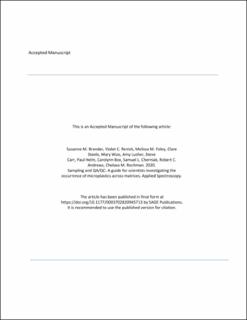| dc.description.abstract | Plastic pollution is a defining environmental contaminant and is considered to be one of the greatest environmental threats of the Anthropocene, with its presence documented across aquatic and terrestrial ecosystems. The majority of this plastic debris falls into the micro (1 μm - 5 mm) or nano (1 - 1000 nm) size range and comes from primary and secondary sources. Its small size makes it cumbersome to isolate and analyze reproducibly, and its ubiquitous distribution creates numerous challenges when controlling for background contamination across matrices (e.g., sediment, tissue, water, air). Although research on microplastics represents a relatively nascent subfield, burgeoning interest in questions surrounding the fate and effects of these debris items creates a pressing need for harmonized sampling protocols and quality control approaches. For results across laboratories to be reproducible and comparable, it is imperative that guidelines based on vetted protocols be readily available to research groups, many of which are either new to plastics research or, as with any new subfield, have arrived at current approaches through a process of trial-and-error rather than in consultation with the greater scientific community. The goals of this manuscript are to a) outline the steps necessary to conduct general as well as matrix-specific quality assurance and quality control based on sample type and associated constraints, b) briefly review current findings across matrices, and c) provide guidance for the design of sampling regimes. Specific attention is paid to the source of microplastic pollution as well as the pathway by which contamination occurs, with details provided regarding each step in the process from generating appropriate questions to sampling design and collection. | en_US |
